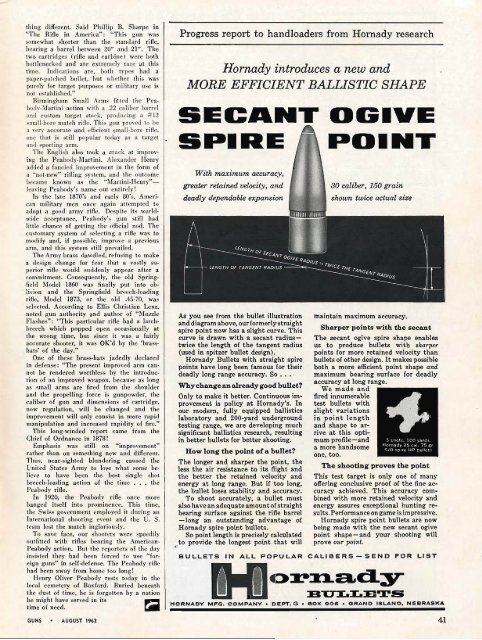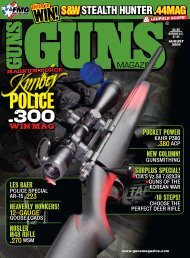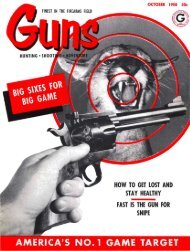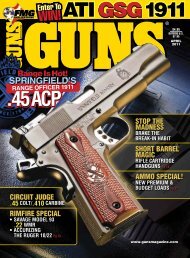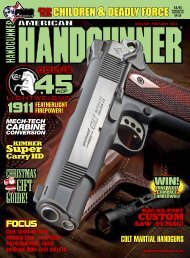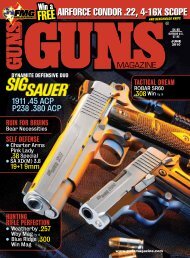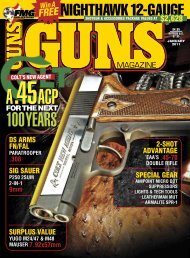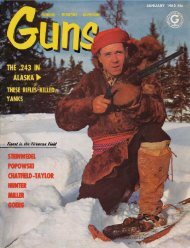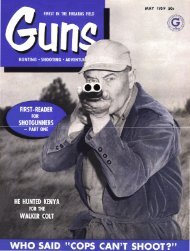You also want an ePaper? Increase the reach of your titles
YUMPU automatically turns print PDFs into web optimized ePapers that Google loves.
thing different. Said Phillip B. Sharpe in<br />
"The Rifle in America": "This gun was<br />
somewhat shorter than the standard rifle,<br />
bearing a barrel between 20" and 21". The<br />
two cartridges (rifle and carbine) Were both<br />
bottlenecked and are extremely rare at this<br />
time. Indications are, both types had a<br />
paper-patched bullet, but whether this was<br />
purely for target purposes or military use is<br />
not established."<br />
Birmingham Small Arms fitted the Peabody-Martini<br />
action with a .22 caliber barrel<br />
and custom target stock, producing a #12<br />
small-bore match rifle. This gun proved to be<br />
a very accurate and efficient small-bore rifle,<br />
one that is still popular today as a target •<br />
and sporting arm.<br />
The English also took a crack at improving<br />
the Peabody-Martini. Alexander Henry<br />
added a fancied improvement in the form of<br />
a "not-new" rifling system, and the outcome<br />
became known as the "Martini-Henry"<br />
leaving Peabody's name out entirely!<br />
In the late 1870's and early 80's, American<br />
military men once again attempted to<br />
adopt a good army rifle. Despite its worldwide<br />
acceptance, Peabody's gun still had<br />
little chance of getting the official nod. The<br />
customary system of selecting a rifle was to<br />
modify and, if possible, improve a previous<br />
arm, and this system still prevailed.<br />
The Army brass dawdled; refusing to make<br />
a design change for fear that a vastly superior<br />
rifle would suddenly appear after a<br />
commitment. Consequently, the old Springfield<br />
Model 1860 was finally put into oblivion<br />
and the Springfield breech-loading<br />
rifle, Model 1873, or the old .45-70, was<br />
selected. According to Ellis Christian Lenz,<br />
noted gun authority lind author of "Muzzle<br />
Flashes": "This particular rifle had a latchbreech<br />
which popped open occasionally at<br />
the wrong time, but since it was a fairly<br />
accurate shooter, it was OK'd by the 'brasshats'<br />
of the day."<br />
One of these brass-hats jadedly declared .<br />
in defense: "The present improved arm cannot<br />
be rendered worthless by the introduction<br />
of an improved weapon, because as long<br />
as small arms are fired from the shoulder<br />
and the propelling force is gunpowder, the<br />
caliber of gun and dimensions of cartridge,<br />
now regulation, will be changed and the<br />
improvement will only consist in more rapid<br />
manipulation and increased rapidity of fire."<br />
This long-winded report came from the<br />
Chief of Ordnance in 1878!<br />
Emphasis was still on "improvement"<br />
rather than on something new and different.<br />
Thus, near-sighted blundering caused the<br />
United States Army to lose what some believe<br />
to have been the best single shot<br />
breech-loading action of the time .•. the<br />
Peabody rifle.<br />
In 1920, the Peabody rifle once more<br />
banged itself into prominence. This time,<br />
the Swiss government employed it during an<br />
International shooting event and the U. S.<br />
team lost the match ingloriously.<br />
To save face, our shooters were speedily<br />
outfitted with rifles bearing the American<br />
Peabody action. But the reporters of the day<br />
insisted they had been forced to use "foreign<br />
guns" in self-defense. The Peabody rifle<br />
had been away from home too long!<br />
Henry Oliver Peabody rests today in the<br />
local cemetery of Boxford. Buried beneath<br />
the dust of time, he is forgotten by a nation<br />
he might have served in its ~<br />
time of need. ~<br />
Progress report to handloaders from Hornady research<br />
Hornady introduces a new and<br />
MORE EFFICIENT BALLISTIC SHAPE<br />
SECANT DOIVE<br />
SPIRE POINT<br />
With maximum accuracy,<br />
greater retained velocity, and<br />
deadly dependable expansion<br />
As you see from tb,e bullet illustration<br />
anddiagram above, ourformerlystraight<br />
spire point now has a slight curve. This<br />
curve is drawn with- a secant radiustwice<br />
the length of the tangent radius<br />
(used in spitzer bullet design).<br />
Hornady Bullets with straight spire<br />
points have long been famous for their<br />
deadly long range accuracy. So ...<br />
Whychangeanalreadygoodbullet?<br />
Only to make it better. Continuous improvement<br />
is policy at Hornady's. In<br />
our modern, fully equipped ballistics<br />
laboratory and 200-yard underground<br />
testing range, we are developing much<br />
significant ballistics research, resulting<br />
in better bullets for better shooting.<br />
How long the point ofa bullet?<br />
The longer and sharper the point, the<br />
less the air resistance to its flight and<br />
the better the retained velocity and<br />
energy at long range. But if too long,<br />
the bullet loses stability and accuracy.<br />
To shoot accurately, a bullet must<br />
also have an adequateamount of straight<br />
bearing surface against the rifle barrel<br />
-long an outstanding advantage of<br />
Hornady spire point bullets.<br />
So point length is precisely calculated<br />
to provide the longest point that will<br />
:-,:<br />
BULLETS IN ALL POPULAR<br />
30 caliber, 150 grain<br />
shown twice actual size<br />
maintain maximum accuracy.<br />
Sharper points with the secant<br />
The secant ogive spire shape enables<br />
us to produce bullets with sharper<br />
points for more retained velocity than<br />
bullets of other design. Itmakes possible<br />
both a more efficient point shape and<br />
maximum bearing surface for deadly<br />
accuracy at long range.<br />
We made and<br />
fired innumerable<br />
test bullets with<br />
slight variations<br />
in point length<br />
and shape to arrive<br />
at this optimum<br />
profile-and<br />
a more handsome<br />
one, too.<br />
The shooting proves the point<br />
This test target is only one of many<br />
offering conclusive proof of the fine accuracy<br />
achieved. This accuracy combined<br />
with more retained velocity and<br />
energy assures exceptional hunting results.Performanceongame<br />
is impressive.<br />
Hornady spire point bullets are now<br />
being made with the new secant ogive<br />
point shape-and your shooting will<br />
prove our point. .<br />
H e>::r:.1o,d. Y<br />
B"U"LLET&<br />
CALIBERS-SEND FOR LIST<br />
HORN4DY MFG. COMPANY. DEPT. G • BOX 906 • GRAND ISLAND, NEBRASKA<br />
<strong>GUNS</strong> AUGUST <strong>1962</strong> 41


